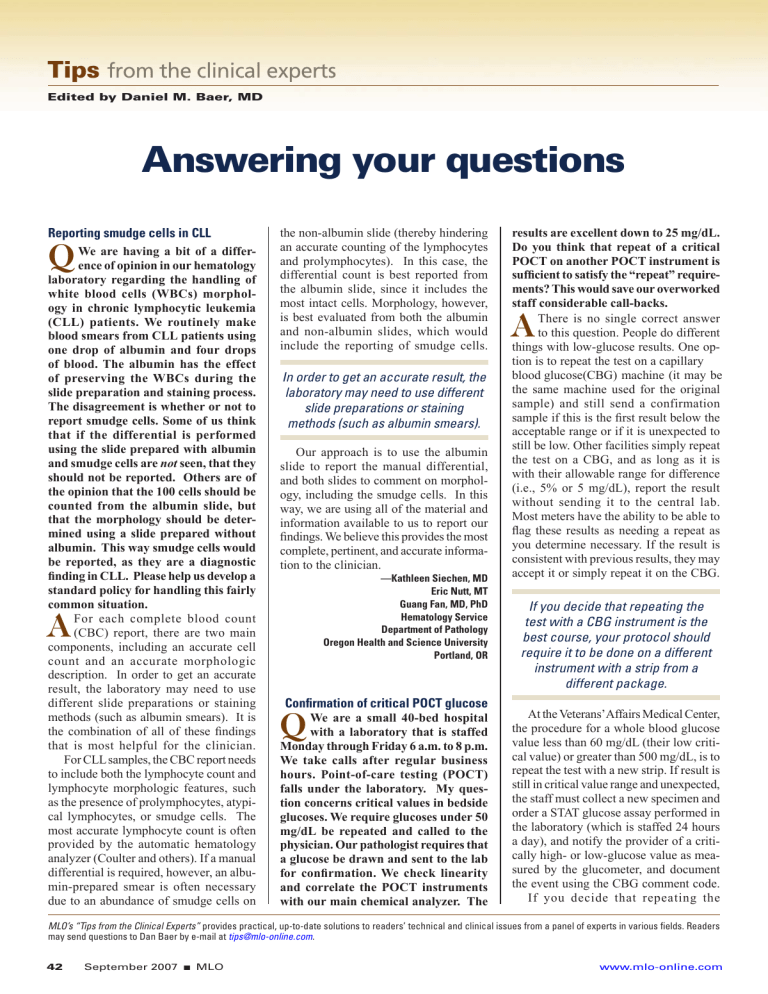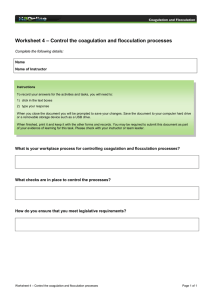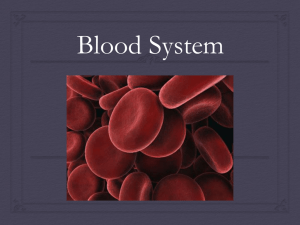Tips from the clinical experts

Postscript
dummy
mechanical
Sign-Off
print proof
neW pdf
revised pdf
MLO
Pg.
42
circle/rs#
lit#
shoWline
i/o check
prod mgr
Nelson Publishing
2500 Tamiami Tr N
Nokomis, FL 34275
1-800-226-6113
Tips
from the clinical experts
Edited by Daniel M. Baer, MD
Answering your questions
Reporting smudge cells in CLL
Q
We are having a bit of a difference of opinion in our hematology laboratory regarding the handling of white blood cells (WBCs) morphology in chronic lymphocytic leukemia
(CLL) patients. We routinely make blood smears from CLL patients using one drop of albumin and four drops of blood. The albumin has the effect of preserving the WBCs during the slide preparation and staining process.
The disagreement is whether or not to report smudge cells. Some of us think that if the differential is performed using the slide prepared with albumin and smudge cells are not seen, that they should not be reported. Others are of the opinion that the 100 cells should be counted from the albumin slide, but that the morphology should be determined using a slide prepared without albumin. This way smudge cells would be reported, as they are a diagnostic finding in CLL. Please help us develop a standard policy for handling this fairly common situation.
A
For each complete blood count
(CBC) report, there are two main components, including an accurate cell count and an accurate morphologic description. In order to get an accurate result, the laboratory may need to use different slide preparations or staining methods (such as albumin smears). It is the combination of all of these findings that is most helpful for the clinician.
For CLL samples, the CBC report needs to include both the lymphocyte count and lymphocyte morphologic features, such as the presence of prolymphocytes, atypical lymphocytes, or smudge cells. The most accurate lymphocyte count is often provided by the automatic hematology analyzer (Coulter and others). If a manual differential is required, however, an albumin-prepared smear is often necessary due to an abundance of smudge cells on the non-albumin slide (thereby hindering an accurate counting of the lymphocytes and prolymphocytes). In this case, the differential count is best reported from the albumin slide, since it includes the most intact cells. Morphology, however, is best evaluated from both the albumin and non-albumin slides, which would include the reporting of smudge cells.
In order to get an accurate result, the laboratory may need to use different slide preparations or staining methods (such as albumin smears).
Our approach is to use the albumin slide to report the manual differential, and both slides to comment on morphology, including the smudge cells. In this way, we are using all of the material and information available to us to report our findings. We believe this provides the most complete, pertinent, and accurate information to the clinician.
—Kathleen Siechen, MD
Eric Nutt, MT
Guang Fan, MD, PhD
Hematology Service
Department of Pathology
Oregon Health and Science University
Portland, OR results are excellent down to 25 mg/dL.
Do you think that repeat of a critical
POCT on another POCT instrument is sufficient to satisfy the “repeat” requirements? This would save our overworked staff considerable call-backs.
A
There is no single correct answer to this question. People do different things with low-glucose results. One option is to repeat the test on a capillary blood glucose(CBG) machine (it may be the same machine used for the original sample) and still send a confirmation sample if this is the first result below the acceptable range or if it is unexpected to still be low. Other facilities simply repeat the test on a CBG, and as long as it is with their allowable range for difference
(i.e., 5% or 5 mg/dL), report the result without sending it to the central lab.
Most meters have the ability to be able to flag these results as needing a repeat as you determine necessary. If the result is consistent with previous results, they may accept it or simply repeat it on the CBG.
Confirmation of critical POCT glucose
Q
We are a small 40-bed hospital with a laboratory that is staffed
Monday through Friday 6 a.m. to 8 p.m.
We take calls after regular business hours. Point-of-care testing (POCT) falls under the laboratory. My question concerns critical values in bedside glucoses. We require glucoses under 50 mg/dL be repeated and called to the physician. Our pathologist requires that a glucose be drawn and sent to the lab for confirmation. We check linearity and correlate the POCT instruments with our main chemical analyzer. The
If you decide that repeating the test with a CBG instrument is the best course, your protocol should require it to be done on a different instrument with a strip from a different package.
At the Veterans’ Affairs Medical Center, the procedure for a whole blood glucose value less than 60 mg/dL (their low critical value) or greater than 500 mg/dL, is to repeat the test with a new strip. If result is still in critical value range and unexpected, the staff must collect a new specimen and order a STAT glucose assay performed in the laboratory (which is staffed 24 hours a day), and notify the provider of a critically high- or low-glucose value as measured by the glucometer, and document the event using the CBG comment code.
If you decide that repeating the
MLO’s “Tips from the Clinical Experts” provides practical, up-to-date solutions to readers’ technical and clinical issues from a panel of experts in various fields. Readers may send questions to Dan Baer by e-mail at tips@mlo-online.com
.
www.mlo-online.com
42 September 2007
■
MLO
test with a CBG instrument is the best course, your protocol should require it to be done on a different instrument with a strip from a different package.
One additional comment: Since CBG testing is done by nurses who have been involved in setting up the testing procedure, they should be involved with the laboratory in making any changes to the existing protocol.
—Mindy Aichele, MT(ASCP), CLS(NCA)
Point-of-Care Coordinator
Formerly at
Oregon Health and Sciences University
Portland, OR
Hemolysis and short samples on coag- ulation tests
Q
What is the latest research data on the effects of hemolysis and short samples on coagulation tests ?
A
The complexity of coagulation and the sophistication of coagulation analytical methods render coagulation testing among the most prone to preanalytical errors in the clinical laboratory.
Hemolysis and under-filling tubes are two very common reasons for rejecting specimens.
1 The following reviews the current thinking on the impact of each issue.
The incidence of hemolysis has increased with the decentralization of phlebotomy practices to non-laboratory personnel. This was primarily due to the collection of blood through venous-access devices or peripheral catheters.
2
Any potential interference observed is related to the extent of hemolysis. Interference from hemolysis generally occurs by two mechanisms, depending upon the analytical system’s method of detection. The lysis of red cells results in the presence of red-cell stroma, and the release of ADP and other pro-coagulant factors. The extent of hemolysis and the presence of these factors activate platelets and, subsequently, the coagulation cascade. For optical-detection instruments, the interference can be longer clotting times, due to the color change from hemoglobin, or shorter times due to the presence of pro-coagulant factors.
Mechanical-detection methods can exhibit shorter clotting times, similar to optical methods, from pro-coagulant factors.
The level of interference from hemolysis is patient dependent.
3,4
Mechanically hemolyzed patient specimens have exhibited significant differences in prothrombin time
(PT) and activated partial thromboplastin time (APTT), compared to non-hemolyzed specimens. No differences were found in healthy subjects.
4
The instrument/reagent manufacturer should be able to provide the user with the level of hemoglobin interference for its assays.
Validating the acceptable level of hemolysis and fill volume in your laboratory setting is good laboratory practice.
Under-filling of collection tubes can occur by premature removal of the tube from the needle, by insufficient transfer from a syringe, or by “natural” factors such as high altitude. Several studies have investigated the effect of under-filling collection tubes on clotting times.
5-7
Under-filling the collection tube alters the blood to additive ratio from
9:1, to <9:1, depending on the actual volume of blood in the tube. The impact of an altered ratio depends upon the concentration of citrate in the tube and upon the patient (i.e., non-anticoagulated patients and heparinized patients).
CLSI recommends the use of 3.2% citrate for coagulation testing.
9
Tubes containing 3.2% citrate are less sensitive to pre-analytical errors than those containing 3.8% citrate, and a laboratory should standardize on one citrate concentration. Clotting times may be prolonged for two reasons: dilutional effects from too much additive or decreased availability of calcium in the assay reaction.
Excess citrate in the plasma will chelate reagent calcium, making it less available for clot formation in the reaction. PT is less susceptible to under-filling than is APTT.
Clinically significant differences
(>15%) were demonstrated at 60% fill for PT and 70% fill for APTT in
3.2% citrate tubes.
7
This holds true for pediatric (2.5 mL) tubes.
8 The greatest effects were observed in specimens from anticoagulated patients.
6-8
CLSI recommends that tubes be rejected if less than 90% filled.
9 Validating the acceptable level of hemolysis and fill volume in your laboratory setting is good laboratory practice.
—Valerie Bush, PhD
Director
Clinical Laboratory and POCT
Bassett Healthcare
Cooperstown, NY
References
1. CAP Q-Probe 92-05, Hematology Specimen Acceptability. College of American Pathologists, Northfield,
IL, 1993.
2. Grant MS. The effect of blood drawing techniques and equipment on the hemolysis of ED laboratory blood samples. J Emer Nurs . 2003;29:116-121.
3. Lippi G, Montagnana M, Salvagno GL, Guidi GC. Interference of blood cell lysis on routine coagulation testing. Arch Pathol Lab Med . 2006;130:181-184.
4. Laga AC, Cheves TA, Sweeney JD. The effect of specimen hemolysis on coagulation test results. Am J Clin
Pathol . 2006;126:748-755.
5. Peterson P, Gottfried EL. The effects of inaccurate blood sample volume on prothrombin time (PT) and activated partial thromboplastin time (aPTT). Thromb Haemostas .
1982;47:101-103.
6. Pai SH, Michalaros K. Effect of sample volume on coagulation tests. Lab Med . 1990;21:371-372.
7. Adcock DM, Kressin DC, Marlar RA. Minimum specimen volume requirements for routine coagulation testing. Am J Clin Pathol . 1998;109:595-599.
8. Chuang J, Sadler MA, Witt DM. Impact of evacuated collection tube fill volume and mixing on routine coagulation testing using 2.5ml (pediatric) tubes. Chest .
2004;126:1262-266.
9. Clinical and Laboratory Standards Institute. Collection, transport, and processing of blood specimens for coagulation testing and performance of coagulation assays. Wayne, PA: CLSI document H21-A4, 1998.
Brushing teeth before fasting glucose
Q
An OB physician has asked about the glucose-tolerance test.
He instructs his patient to fast for 12 hours and not to eat or drink anything, not even water. He also instructs them not to brush their teeth. I could not find anything specific as to what type of fasting was allowed. As long as the patient does not introduce sugar or a compound that can be broken down into sugar, should toothbrushing not be allowed? Does toothpaste have sugar (glucose) in it? For the good of the patient, I hope you can help.
A
Fasting is defined as a 12-hour overnight restriction of everything except water and medications. The limitations your OB physician is imposing seem overly restrictive and without support in the literature. No studies or articles on diabetic testing recommend abstaining from water or from brushing one’s teeth prior to a glucose-tolerance test. An extensive literature search failed to find any study on the effects of toothpaste on blood-sugar levels.
Nevertheless, I contacted several toothpaste manufacturers and asked if their products contain any sugars. The
Colgate Palmolive Office of Consumer
Affairs said Colgate does not contain sugar, saying it “would defeat the purpose of toothpaste.” According to a
Continues on page 44
MLO
■
September 2007 43 www.mlo-online.com
Postscript
dummy
mechanical
Sign-Off
print proof
neW pdf
revised pdf
MLO
Pg.
43
circle/rs#
lit#
shoWline
i/o check
prod mgr
Nelson Publishing
2500 Tamiami Tr N
Nokomis, FL 34275
1-800-226-6113
Postscript
dummy
mechanical
Sign-Off
print proof
neW pdf
revised pdf
MLO
Pg.
44
circle/rs#
lit#
shoWline
i/o check
prod mgr
Nelson Publishing
2500 Tamiami Tr N
Nokomis, FL 34275
1-800-226-6113
Clinical catalog
A new Product and Services catalog is now available, featuring urinalysis, general and specialty chemistry controls, whole blood, electrophoresis systems, and diagnostic assays. Readers can receive this company’s catalog by request (use
MLO’s RSLeads below).
Quantimetrix
Visit www.rsleads.com/709ml-163
Interested in submitting your new product, service, or technology to MLO’s Industry Spotlight? Send only items that are currently available in the m a r k e t p l a c e . U p g r a d e s o f existing products and services are also acceptable. Submissions are accepted via e-mail at mlo-admin@nelsonpub.com or by regular mail. Limit copy to
50 words. ( MLO reserves the right to edit.) Provide a color photograph (5x7, at least 300 dpi, JPG or TIF). Appropriate products are kept on file for 120 days and are used when space is available. Deadline for submission is 60 to 90 days prior to the desired publication issue dates. Note : Because of the number of submissions MLO receives, its staff members cannot verify receipt of Industry
Spotlight submissions by e-mail or by telephone.
Continued from page 43 company spokesperson, Colgate Total contains sorbitol and glycerine (“sugar alcohols”). For sweeteners, both Crest and Colgate products use sodium saccharin. Even though trace amounts of sorbitol and glycerine may be ingested or absorbed while brushing, they are thought to have little to no effect on blood-sugar levels as tested in the clinical laboratory.
If one were to follow the physician’s logic in discouraging toothpaste, of greater concern would be those patients who opt to use a mouthwash instead.
Sorbitol and glycerine are in much higher concentrations in most mouthwashes than in toothpaste and are probably more readily absorbed. Hand lotions and shampoos also may contain the same sugar alcohols as toothpaste. Clearly, toothpaste is only the “tip of the iceberg” when it comes to the potential effects of consumer products on glucose-tolerance testing. But none have been found to interfere to a clinically significant degree.
44
!33!9
The Assay You Can Trust . . .
)MMUNOASSAY2EAGENTS
FOR#HEMISTRY!NALYZERS
Í s
&ERRITIN
/URFERRITINREAGENTOFFERSTHEBESTPERFORMANCE
WITHTHELOWESTCOSTPERTESTONTHEMARKET
7IDESTMEASURINGRANGENGM,
,ESSINTERFERENCEFROMRHEUMATOIDFACTORS
,ESSHIGHDOSEHOOKEFFECT
3ERUMORPLASMASAMPLES
#OMPATIBLEWITHANYBLOODCOLLECTIONTUBE
!DAPTABLETOMOSTCHEMISTRYANALYZERSINCLUDING
!BBOTT!EROSET
§ "AYER/PERA § ),!"
!BBOTT!RCHITECT
§ # §
!LFA7ASSERMANN!#% §
!LFA7ASSERMANN!LERA
§
"AYER!DVIA
§
"AYER!DVIA
§
"ECKMAN3YNCHRON#8 §
"ECKMAN3YNCHRON,8 §
#OBAS-IRA § &ARA §
$ADE$IMENSION §
),!"
/LYMPUS § !5
Í SERIES
2OCHE(ITACHI
SERIES
3TANBIO3IRRUS §
&OR INVITRO DIAGNOSTICUSE
+!-)9!")/-%$)#!,#/-0!.9
'ATEWAY$RIVE3EATTLE7!
WWWKAMIYABIOMEDICALCOM
FAX
Visit www.rsleads.com/709ml-016
September 2007
■
MLO
0-
Even though trace amounts of sorbitol and glycerine may be ingested or absorbed while brushing, they are thought to have little to no effect on blood-sugar levels as tested in the clinical laboratory.
If the physician insists on imposing these restrictions, I suggest you let it go. They are minor, albeit unnecessary, inconveniences to the patient. I would not go so far as to turn patients away who use toothpaste or drink water prior to a glucose-tolerance test. Nor would I document the use of toothpaste or the ingestion of water with the test results. I think the physician is overreacting to what is only a perceived interference. l
—Dennis Ernst, MT(ASCP)
Director
Center for Phlebotomy Education
Coalition for Phlebotomy Personnel Standards
Ramsey, IN
Daniel M. Baer, MD, is professor emeritus of laboratory medicine at Oregon Health and
Science University in Portland,
OR, and a member of MLO’s editorial advisory board.
www.mlo-online.com


